Comparative Study on the Generation and Characteristics of Debris Induced by Fretting and Sliding
Abstract
:1. Introduction
2. Experimental Details
2.1. Materials and Specimens
2.2. Testing Rig and Parameters
2.3. Analysis Methods
3. Results and Discussion
3.1. Optical Observation
3.2. SEM Observation
3.3. Particle Size Analysis
3.4. Element and Phase Analyses
4. Conclusions
- The generated sliding wear debris was about twice that of the fretting wear debris. This is because for a sliding worn surface, without the protection of a thick debris layer, direct metal-to-metal contact occurs, leading to an increase in adhesive and abrasive wear.
- The fretting debris was mainly formed by fine particles due to repeated crushing and grinding. The sliding debris contained not only fine particles but also large flakes and chips as part of the debris moved out of the contact area.
- Element and phase analyses indicated that a violent oxidation reaction occurred during both the fretting and sliding wear processes. The phase makeup of the fretting and sliding debris was mainly copper and its oxides.
Author Contributions
Funding
Institutional Review Board Statement
Informed Consent Statement
Data Availability Statement
Conflicts of Interest
References
- Lemm, J.D.; Warmuth, A.R.; Pearson, S.R.; Shipway, P.H. The influence of surface hardness on the fretting wear of steel pairs—Its role in debris retention in the contact. Tribol. Int. 2015, 81, 258–266. [Google Scholar] [CrossRef]
- Tang, P.; Mi, X.; Zhang, J.; Xiong, F.R.; Zheng, B.; Shao, X.J.; Zhu, M.H. Evolution of wear damage in 690 alloy tube mated with 405 stainless steel plate due to fretting conditions. Tribol. Int. 2021, 163, 107177. [Google Scholar] [CrossRef]
- Sheng, S. Monitoring of Wind Turbine Gearbox Condition through Oil and Wear Debris Analysis: A Full-Scale Testing Perspective. Tribol. Trans. 2016, 59, 149–162. [Google Scholar] [CrossRef]
- Li, T.; Wang, S.; Zio, E.; Shi, J.; Ma, Z. A numerical approach for predicting the remaining useful life of an aviation hydraulic pump based on monitoring abrasive debris generation. Mech. Syst. Signal Process. 2020, 136, 106519. [Google Scholar] [CrossRef]
- Mi, X.; Xie, H.; Tang, P.; Cai, Z.B.; Peng, J.F.; Zhu, M.H. Effect of environmental condition on the chemical behavior of 690 alloy during fretting wear. Tribol. Int. 2020, 146, 106202. [Google Scholar] [CrossRef]
- Korashy, A.; Attia, H.; Thomson, V.; Oskooei, S. Fretting wear behavior of cobalt-Based superalloys at high temperature—A comparative study. Tribol. Int. 2020, 145, 106155. [Google Scholar] [CrossRef]
- Attia, M.H.; de Pannemaecker, A.; Williams, G. Effect of temperature on tribo-oxide formation and the fretting wear and friction behavior of zirconium and nickel-based alloys. Wear 2021, 203722. [Google Scholar] [CrossRef]
- Godjevac, M. Wear and Friction in a Controllable Pitch Propeller. Ph.D. Thesis, Delft University of Technology, Delft, The Netherlands, 2010. [Google Scholar]
- Kirk, A.M.; Shipway, P.H.; Sun, W.; Bennett, C.J. Debris development in fretting contacts–Debris particles and debris beds. Tribol. Int. 2020, 149, 105592. [Google Scholar] [CrossRef]
- Everitt, N.M.; Ding, J.; Bandak, G.; Shipway, P.H.; Leen, S.B.; Williams, E.J. Characterisation of fretting-induced wear debris for Ti-6Al-4 V. Wear 2009, 267, 283–291. [Google Scholar] [CrossRef]
- Blades, L.; Hills, D.; Nowell, D.; Evans, K.E.; Smith, C. An exploration of debris types and their influence on wear rates in fretting. Wear 2020, 450, 203252. [Google Scholar] [CrossRef]
- Soria, S.R.; Tolley, A.; Yawny, A. A study of debris and wear damage resulting from fretting of Incoloy 800 steam generator tubes against AISI Type 304 stainless steel. Wear 2016, 368, 219–229. [Google Scholar] [CrossRef]
- Fan, B.; Li, B.; Feng, S.; Mao, J.; Xie, Y.B. Modeling and experimental investigations on the relationship between wear debris concentration and wear rate in lubrication systems. Tribol. Int. 2017, 109, 114–123. [Google Scholar] [CrossRef] [Green Version]
- Nine, M.J.; Choudhury, D.; Hee, A.C.; Mootanah, R.; Osman, N.A.A. Wear debris characterization and corresponding biological response: Artificial hip and knee joints. Materials 2014, 7, 980–1016. [Google Scholar] [CrossRef] [PubMed] [Green Version]
- Fischer, T.E.; Zhu, Z.; Kim, H.; Shin, D.S. Genesis and role of wear debris in sliding wear of ceramics. Wear 2000, 245, 53–60. [Google Scholar] [CrossRef]
- Karger-Kocsis, J.; Felhös, D.; Thomann, R. Tribological behavior of a carbon-nanofiber-modified santoprene thermoplastic elastomer under dry sliding and fretting conditions against steel. J. Appl. Polym. Sci. 2008, 108, 724–730. [Google Scholar] [CrossRef]
- Diomidis, N.; Mischler, S.; More, N.S.; Roy, M. Tribo-electrochemical characterization of metallic biomaterials for total joint replacement. Acta Biomater. 2012, 8, 852–859. [Google Scholar] [CrossRef]
- Laux, K.A.; Sue, H.J.; Montoya, A.; Bremner, T. Wear behavior of polyaryletherketones under multi-directional sliding and fretting conditions. Tribol. Lett. 2015, 58, 1–13. [Google Scholar] [CrossRef]
- Zhang, P.; Lu, W.; Liu, X.; Zhai, W.; Zhou, M.; Wang, J. Torsional fretting wear behavior of CuNiAl against 42CrMo4 under flat on flat contact. Wear 2017, 380, 6–14. [Google Scholar] [CrossRef]
- Zhang, P.; Lu, W.; Liu, X.; Zhai, W.; Zhou, M.; Jiang, X.J. A comparative study on torsional fretting and torsional sliding wear of CuNiAl under different lubricated conditions. Tribol. Int. 2018, 117, 78–86. [Google Scholar] [CrossRef]
- Lu, W.; Zhang, P.; Liu, X.; Zhai, W.; Zhou, M.; Luo, J.; Jiang, X. Influence of surface topography on torsional fretting wear under flat-on-flat contact. Tribol. Int. 2017, 109, 367–372. [Google Scholar] [CrossRef]
- Torstensson, P.T.; Pieringer, A.; Nielsen, J.C.O. Simulation of rail roughness growth on small radius curves using a non-Hertzian and non-steady wheel–rail contact model. Wear 2014, 314, 241–253. [Google Scholar] [CrossRef] [Green Version]
- Zhang, P.; Zeng, L.; Mi, X.; Lu, Y.; Luo, S.; Zhai, W. Comparative study on the fretting wear property of 7075 aluminum alloys under lubricated and dry conditions. Wear 2021, 474, 203760. [Google Scholar] [CrossRef]
- Zhang, P.; Liu, X.; Lu, W.; Zhai, W.; Zhou, M.; Wang, J. Fretting wear behavior of CuNiAl against 42CrMo4 under different lubrication conditions. Tribol. Int. 2018, 117, 59–67. [Google Scholar] [CrossRef]
- Mi, X.; Cai, Z.B.; Xiong, X.M.; Qian, H.; Tang, L.C.; Xie, Y.C.; Zhu, M.H. Investigation on fretting wear behavior of 690 alloy in water under various temperatures. Tribol. Int. 2016, 100, 400–409. [Google Scholar] [CrossRef] [Green Version]
- Zhang, P.; Lu, W.; Liu, X.; Zhai, W.; Zhou, M.; Zeng, W. Torsional fretting and torsional sliding wear behaviors of CuNiAl against 42CrMo4 under dry condition. Tribol. Int. 2018, 118, 11–19. [Google Scholar] [CrossRef]
- Fillot, N.; Iordanoff, I.; Berthier, Y. Wear modeling and the third body concept. Wear 2007, 262, 949–957. [Google Scholar] [CrossRef]
- Argatov, I.I.; Chai, Y.S. A self-similar model for fretting wear contact with the third body in gross slip. Wear 2021, 466, 203562. [Google Scholar] [CrossRef]
- Yin, M.; Cai, Z.; Yu, Y.; Zhu, M.H. Impact-sliding wear behaviors of 304SS influenced by different impact kinetic energy and sliding velocity. Tribol. Int. 2020, 143, 106057. [Google Scholar] [CrossRef]
- Xin, L.; Ma, M.; Lu, Y.; Shoji, T. Comparative study on fretting wear behaviors of Alloy 600MA in dry air and deionized water conditions. Wear 2019, 418, 167–179. [Google Scholar] [CrossRef]
- García-Rodríguez, S.; Torres, B.; Maroto, A.; López, A.J.; Otero, E.; Rams, J. Dry sliding wear behavior of globular AZ91 magnesium alloy and AZ91/SiCp composites. Wear 2017, 390, 1–10. [Google Scholar] [CrossRef]
- Surya, M.S.; Gugulothu, S. Fabrication, mechanical and wear characterization of silicon carbide reinforced Aluminium 7075 metal matrix composite. Silicon 2022, 14, 2023–2032. [Google Scholar] [CrossRef]
- Surya, M.S.; Prasanthi, G.; Gugulothu, S. Investigation of mechanical and wear behaviour of Al7075/SiC composites using response surface methodology. Silicon 2021, 13, 2369–2379. [Google Scholar] [CrossRef]




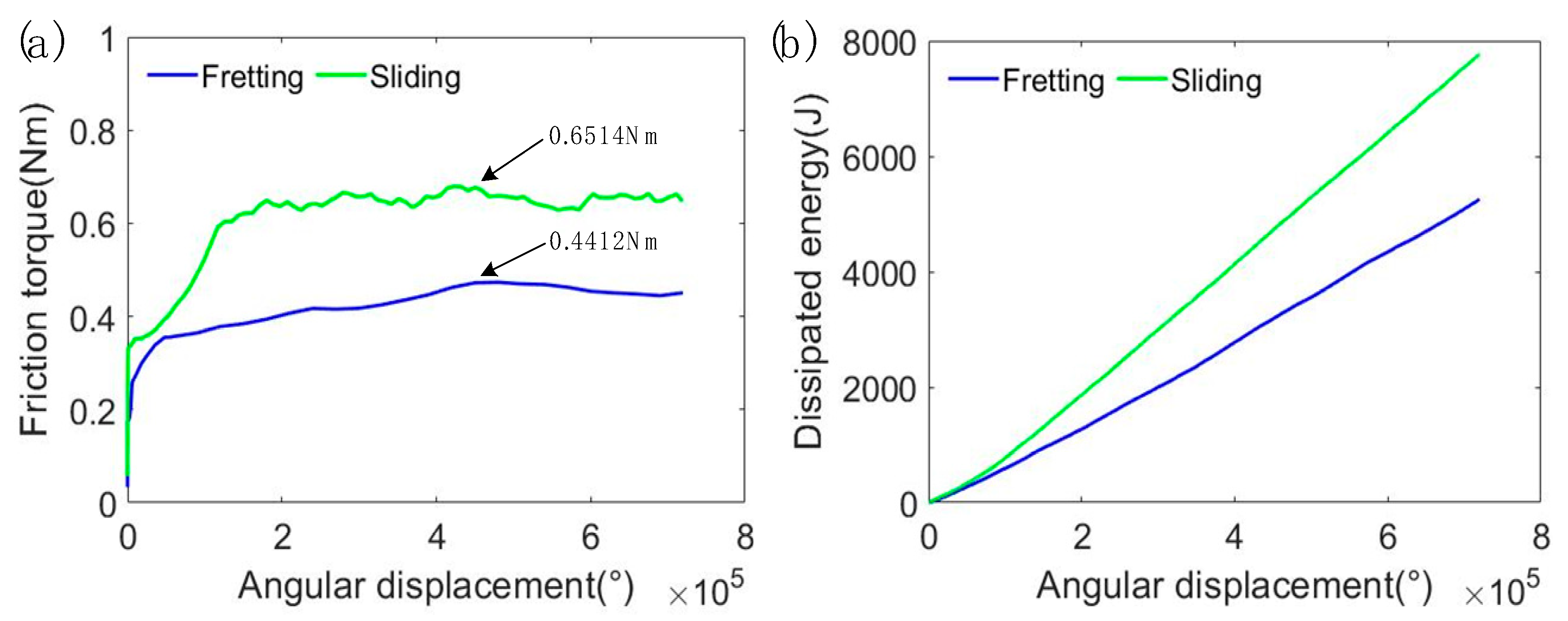
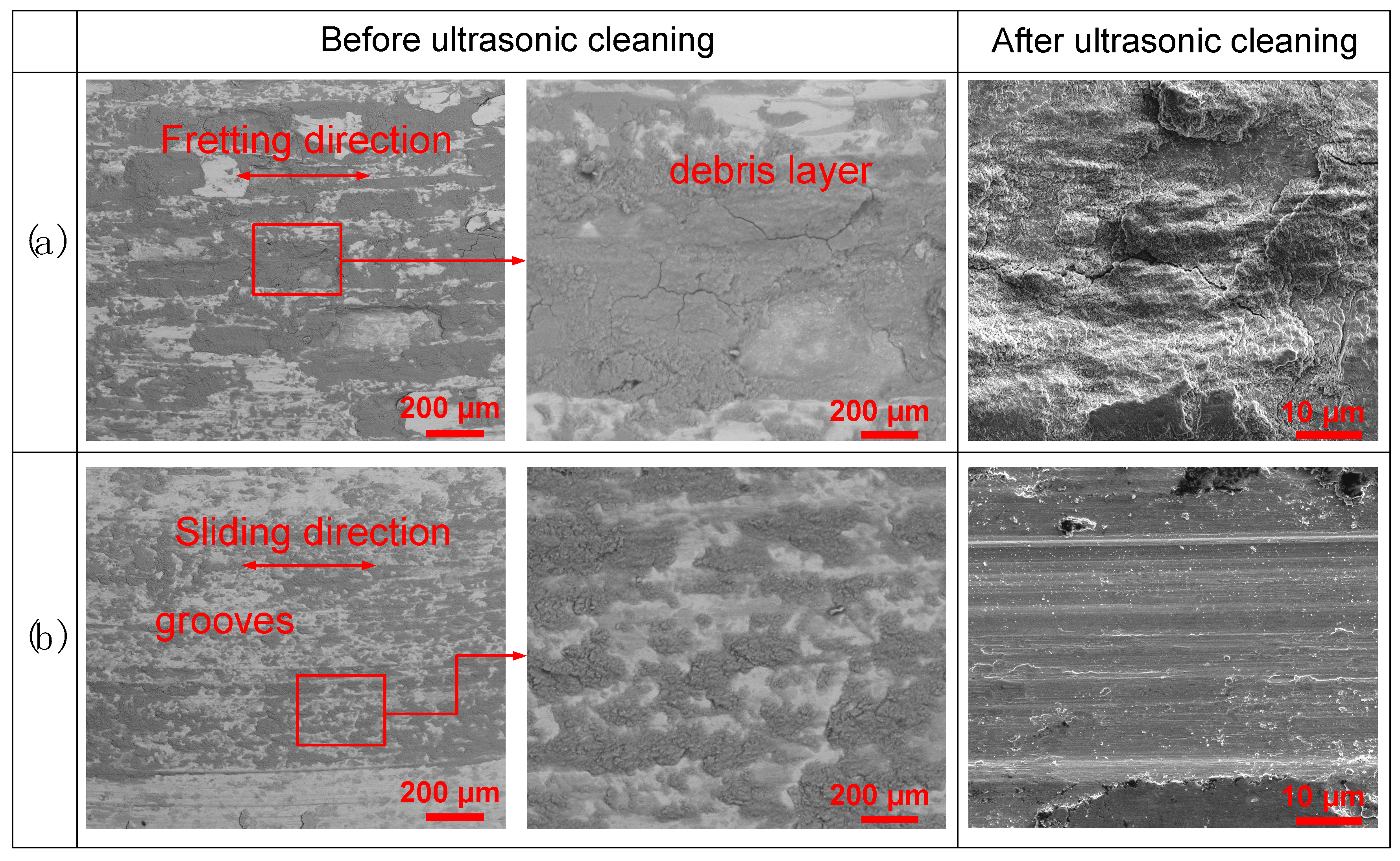
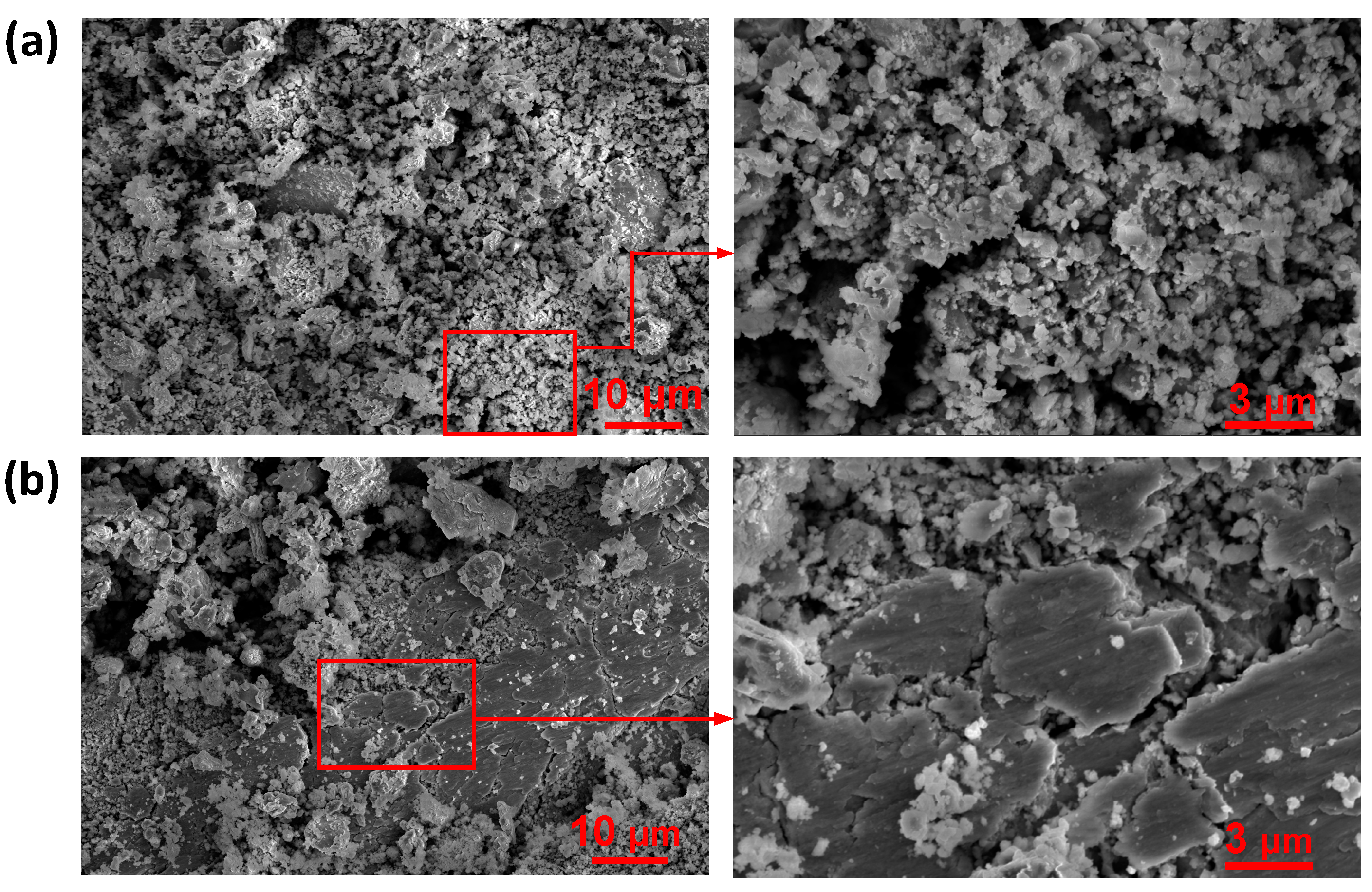
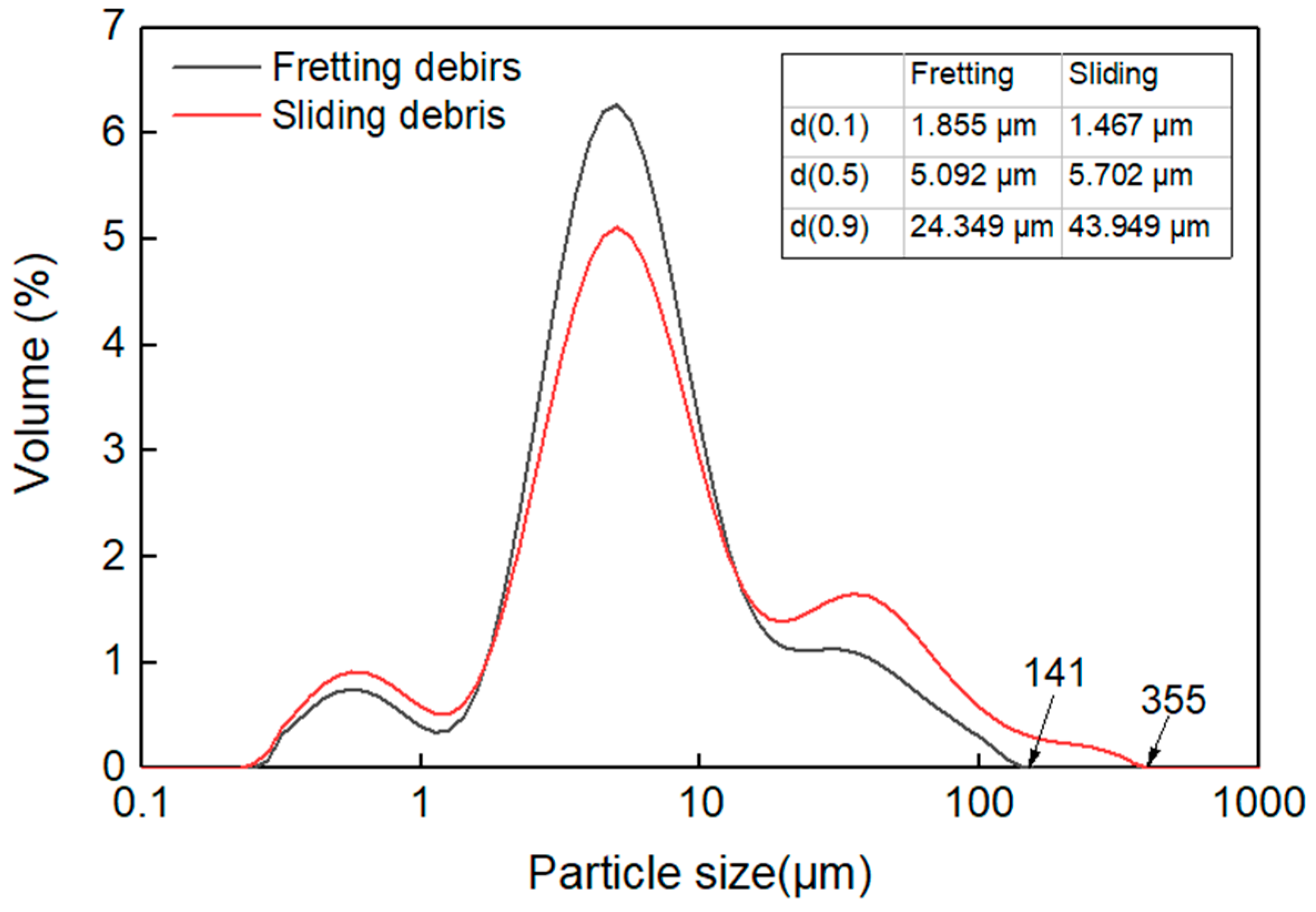

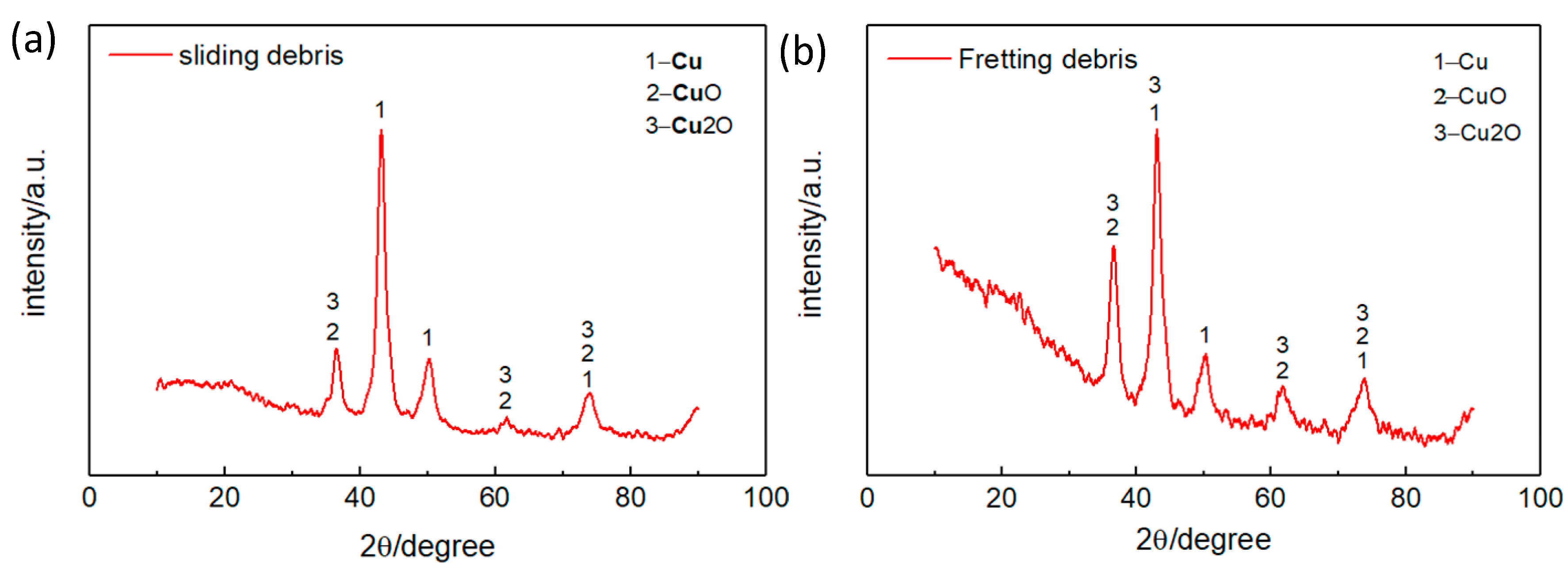
| Load (N) | Amplitude (°) | Speed(°/s) | Number of Cycles | Total Angular Displacement (°) | Frequency (Hz) | |
|---|---|---|---|---|---|---|
| Fretting | 106 | 1.5 | 18 | 120,000 | 720,000 | 3 |
| Sliding | 106 | 22.5 | 18 | 8000 | 720,000 | 0.2 |
Publisher’s Note: MDPI stays neutral with regard to jurisdictional claims in published maps and institutional affiliations. |
© 2022 by the authors. Licensee MDPI, Basel, Switzerland. This article is an open access article distributed under the terms and conditions of the Creative Commons Attribution (CC BY) license (https://creativecommons.org/licenses/by/4.0/).
Share and Cite
Zhang, P.; Cai, Z.; Yang, W.; Chen, J.; Luo, S.; Zeng, L. Comparative Study on the Generation and Characteristics of Debris Induced by Fretting and Sliding. Materials 2022, 15, 4132. https://doi.org/10.3390/ma15124132
Zhang P, Cai Z, Yang W, Chen J, Luo S, Zeng L. Comparative Study on the Generation and Characteristics of Debris Induced by Fretting and Sliding. Materials. 2022; 15(12):4132. https://doi.org/10.3390/ma15124132
Chicago/Turabian StyleZhang, Po, Zhaobing Cai, Wenjun Yang, Juan Chen, Shiyuan Luo, and Liangcai Zeng. 2022. "Comparative Study on the Generation and Characteristics of Debris Induced by Fretting and Sliding" Materials 15, no. 12: 4132. https://doi.org/10.3390/ma15124132
APA StyleZhang, P., Cai, Z., Yang, W., Chen, J., Luo, S., & Zeng, L. (2022). Comparative Study on the Generation and Characteristics of Debris Induced by Fretting and Sliding. Materials, 15(12), 4132. https://doi.org/10.3390/ma15124132







